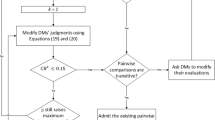Abstract
Gradually, the previously proposed water resource management schemes and reservoir operating policies adjusted to the historically experienced climatic conditions are losing their validity and efficacy, urging building up the models compatible with the likely climatic change conditions at the future. This paper aims at optimizing the reservoir operation under climate change conditions targeting the objectives including (1) minimizing the shortages in meeting the reservoir downstream water demands and (2) maximizing the sustainability of the reservoir storage. For evaluating the effects of the climate change, six general circulation models (GCMs) built up under the representative concentration pathway (RCP4.5) emission scenario are adopted and utilized to predict the climate variables over a 30-year planning period. To solve this problem, an improved version of our recently proposed fuzzy multi-objective particle swarm optimization (f-MOPSO) algorithm, named f-MOPSO-II, is proposed. The f-MOPSO takes a novel approach to handle multi-objective nature of the optimization problems. In this approach, the common concept of “diversity” is replaced with “extremity,” to choose the better guides of the search agents in the algorithm. The f-MOPSO-II is based on the f-MOPSO. However, it is aimed at simultaneously mitigating the f-MOPSO computational complexity and enhancing the quality of the final results presented by this algorithm. The results obtained by the f-MOPSO-II were then compared with those yielded by the popular non-dominated sorting genetic algorithm-II (NSGA-II). As the results suggest, the f-MOPSO-II is capable of simultaneously meeting the water demands and holding the reservoir storage sustainable, much better than the NSGA-II.





Similar content being viewed by others
Data availability
All data used in this paper are available from the corresponding author by request.
References
Akurut, M., Willems, P., & Niwagaba, C. B. (2014). Potential impacts of climate change on precipitation over Lake Victoria, East Africa, in the 21st Century. Water, 6(9), 2634–2659.
Al-Jawad, J. Y., & Tanyimboh, T. T. (2017). Reservoir operation using a robust evolutionary optimization algorithm. Journal of Environmental Management, 197, 275–286.
Anandhi, A., Frei, A., Pierson, D. C., Schneiderman, E. M., Zion, M. S., Lounsbury, D., & Matonse, A. H. (2011). Examination of change factor methodologies for climate change impact assessment. Water Resources Research. https://doi.org/10.1029/2010WR009104
Anderson, M. G., & Burt, T. P. (1985). Hydrological forecasting.
Azmat, M., Qamar, M. U., Huggel, C., & Hussain, E. (2018). Future climate and cryosphere impacts on the hydrology of a scarcely gauged catchment on the Jhelum river basin, Northern Pakistan. Science of the Total Environment, 639, 961–976.
Bozorg-Haddad, O., Aboutalebi, M., Ashofteh, P.-S., & Loáiciga, H. A. (2018). Real-time reservoir operation using data mining techniques. Environmental Monitoring and Assessment, 190, 594.
Bozorg-Haddad, O., Solgi, M., & Loáiciga, H. A. (2017). Meta-heuristic and Evolutionary Algorithms for Engineering Optimization. Hoboken, USA, John Wiley & Sons, Inc.
Chang, J. X., Bai, T., Huang, Q., & Yang, D. W. (2013). Optimization of water resources utilization by PSO-GA. Water Resources Management, 27(10), 3525–3540.
Coello, C. A., & Lechuga, M. S. (2002). MOPSO: A proposal for multiple objective particle swarm optimization. In: Proc. IEEE Congress on Evolutionary Computation (CEC’2002), May. IEEE Service Center. Piscataway, NJ, 2, 1677–1681.
Deb, K., Pratap, A., Agarwal, S., & Meyarivan, T. (2002). A fast and elitist multiobjective genetic algorithm: NSGA-II. IEEE Transactions on Evolutionary Computation, 6(2), 182–197.
Dingman, S. L., Seely-Reynolds, D. M., & Reynolds, R. C., III. (1988). Application of kriging to estimating mean annual precipitation in a region of orographic influence 1. JAWRA Journal of the American Water Resources Association, 24(2), 329–339.
Fallah-Mehdipour, E., Bozorg-Haddad, O., & Mariño, M. A. (2011). MOPSO algorithm and its application in multipurpose multireservoir operations. Journal of Hydroinformatics, 13(4), 794–811.
Fang, R., & Popole, Z. (2020). Multi-objective optimized scheduling model for hydropower reservoir based on improved particle swarm optimization algorithm. Environmental Science and Pollution Research, 27(12), 12842–12850.
Gohari, A., Eslamian, S., Abedi-Koupaei, J., Bavani, A. M., Wang, D., & Madani, K. (2013). Climate change impacts on crop production in Iran’s Zayandeh-Rud River Basin. Science of the Total Environment, 442, 405–419.
Guo, X., Hu, T., Wu, C., Zhang, T., & Lv, Y. (2013). Multi-objective optimization of the proposed multi-reservoir operating policy using improved NSPSO. Water Resources Management, 27, 2137–2153.
Guo, S., Wang, J., Xiong, L., Ying, A., & Li, D. (2002). A macro-scale and semi-distributed monthly water balance model to predict climate change impacts in China. Journal of Hydrology, 268(1–4), 1–15.
Jahandideh-Tehrani, M., Bozorg-Haddad, O., & Loáiciga, H. A. (2020). Application of particle swarm optimization to water management: An introduction and overview. Environmental Monitoring and Assessment. https://doi.org/10.1007/s10661-020-8228-z
Karimi, N., Zandieh, M., & Karamooz, H. R. (2010). Bi-objective group scheduling in hybrid flexible flowshop: A multi-phase approach. Expert Systems with Applications, 37, 4024–4032.
Kennedy, J., & Eberhart, R. C. (1995). Particle swarm optimization, Proceedings of IEEE International Conference on Neural Networks.
Kumar, D. N., & Reddy, M. J. (2007). Multipurpose reservoir operation using particle swarm optimization. Journal of Water Resources Planning and Management, 133(3), 192–201.
Li, T., & Tang, W. (2012). An improved adaptive particle swarm optimization algorithm. Information Engineering and Applications, 331–338.
Liang, J. J., Qin, A. K., Suganthan, P. N., & Baskar, S. (2006). Comprehensive learning particle swarm optimizer for global optimization of multimodal functions. IEEE Transactions on Evolutionary Computation, 10(3), 281–295.
Liu, Y. (2009). Automatic calibration of a rainfall-runoff model using a fast and elitist multi-objective particle swarm algorithm. Experts Syst Appl, 36, 9533–9538.
Liu, B., Wang, L., Jin, Y., Tang, F., & Huang, D. (2005). Improved particle swarm optimization combined with chaos. Chaos, Solitons & Fractals, 25, 1261–1271.
Mason, S. J. (2004). Simulating climate over western North America using stochastic weather generators. Climatic Change, 62(1–3), 155–187.
Mirfenderesgi, G., & Mousavi, S. J. (2016). Adaptive metamodeling-based simulation optimization in basin-scale optimum water allocation: A comparative analysis of metamodels. Journal of Hydroinformatics, 18(4). https://doi.org/10.2166/hydro.2015.157
Muttiah, R. S., & Wurbs, R. A. (2002). Modeling the impacts of climate change on water supply reliabilities. Water International, 27(3), 407–419.
Neboh, N., Adeyemo, J., Enitan, A., & Olugbara, O. (2015). A review on applications of evolutionary algorithms to reservoir operation for hydropower production. International Journal of Geological and Environmental Engineering, 9(9). https://doi.org/10.5281/zenodo.1109762
Nguyen, P., Thorstensen, A., Sorooshian, S., Zhu, Q., Tran, H., Ashouri, H., Miao, C., Hsu, K., & Gao, X. (2017). Evaluation of CMIP5 model precipitation using PERSIANN-CDR. Journal of Hydrometeorology, 18(9), 2313–2330.
Niu, W.-J., Feng, Z.-K., Cheng, C.-T., & Wu, X.-Y. (2018). A parallel multi-objective particle swarm optimization for cascadehydropower reservoir operation in southwest China. Applied Soft Computing, 70, 562–575.
Ostadrahimi, L., Mariño, M. A., & Afshar, A. (2012). Multireservoir operation rules: Multi-swarm PSO-based optimization approach. Water Resources Management, 26(2), 407–427.
Parsopoulos, K. E., Plagianakos, V. P., Magoulas, G. D., & Vrahatis, M. N. (2001). Stretching technique for obtaining global minimizers through particle swarm optimization. Proceedings of the Particle Swarm Optimization workshop, 22–29.
Pichuka, S., Prasad, R., Maity, R., & Kunstmann, H. (2017). Development of a method to identify change in the pattern of extreme streamflow events in future climate: Application on the Bhadra reservoir inflow in India. Journal of Hydrology: Regional Studies, 9, 236–246.
Reddy, M. J., & Kumar, D. N. (2007). Multi-objective particle swarm optimization for generating optimal trade-offs in reservoir operation. Hydrological Processes, 21(21), 2897–2909.
Rezaei, F., Safavi, H. R., Mirchi, A., & Madani, K. (2017a). f-MOPSO: An alternative multi-objective PSO algorithm for conjunctive water use management. Journal of Hydro-Environment Research, 14, 1–18.
Rezaei, F., Safavi, H. R., & Zekri, M. (2017b). A hybrid fuzzy-based multi-objective PSO algorithm for conjunctive water use and optimal multi-crop pattern planning. Water Resources Management, 31(4), 1139–1155.
Robinson, J., Sinton, S., & Rahmat-Samii, Y. (2002). Particle swarm, genetic algorithm, and their hybrids: Optimization of a profiled corrugated horn antenna. Antennas and Propagation Society International Symposium, IEEE, San Antonio, TX, 1, 314–317.
Schott, J. R. (1995). Fault tolerant design using single and multicriteria genetic algorithm optimization (No. AFIT/CI/CIA-95–039). Air Force Inst of Tech Wright-Patterson AFB OH.
Sepahvand, R., Safavi, H. R., & Rezaei, F. (2019). Multi-objective planning for conjunctive use of surface and ground water resources using genetic programming. Water Resources Management, 33(6), 2123–2137.
Sierra, M. R., & Coello, C. A. C. (2005). Improving PSO-based multi-objective optimization using crowding, mutation and ε-dominance. In Proceedings of Evolutionary Multi-Criterion Optimization.
Silberstein, R. P., Aryal, S. K., Durrant, J., Pearcey, M., Braccia, M., Charles, S. P., Boniecka, L., Hodgson, G. A., Bari, M. A., Viney, N. R., & McFarlane, D. J. (2012). Climate change and runoff in south-western Australia. Journal of Hydrology, 475, 441–455.
Solgi, M., Bozorg-Haddad, O., & Loáiciga, H. A. (2016). The enhanced honey-bee mating optimization algorithm for water resources optimization. Water Resources Management. https://doi.org/10.1007/s11269-016-1553-x
Sun, J., Feng, B., & Xu,W. (2004). “Particle swarm optimization with particles having quantum behavior”, IEEE Proc. Of Congress on Evolutionary Computation, June.
Tao, F., & Zhang, Z. (2010). Adaptation of maize production to climate change in North China Plain: Quantify the relative contributions of adaptation options. European Journal of Agronomy, 33(2), 103–116.
Trivedi, M., & Shrivastava, R. (2020). Derivation and performance evaluation of optimal operating policies for a reservoir using a novel PSO with elitism and variational parameters. Urban Water Journal. https://doi.org/10.1080/1573062X.2020.1823431
Wang, Q., Zhou, H., Liang, G., & Xu, H. (2015). Optimal operation of bidirectional inter-basin water transfer-supply system. Water Resources Management, 29(9), 3037–3054.
Wu, J., Long, J., & Miu, M. (2015). Evolving RBF neural networks for rainfall prediction using hybrid particle swarm optimization and genetic algorithm. Neurocomputing, 148, 136–142.
Yang, Z., Yang, K., Wang, Y., Su, L., & Hu, H. (2020). Multi-objective short-term hydropower generation operation for cascade reservoirs and stochastic decision making under multiple uncertainties. Journal of Cleaner Production, 276. https://doi.org/10.1016/j.jclepro.2020.122995
Zhang, Z., Jiang, Y., Zhang, S., Geng, S., Wang, H., & Sang, G. (2014). An adaptive particle swarm optimization algorithm for reservoir operation optimization. Applied Soft Computing, 18, 167–177.
Zhang, H., Wang, B., Liu, D. L., Zhang, M., Feng, P., Cheng, L., Yu, Q., & Eamus, D. (2019). Impacts of future climate change on water resource availability of eastern Australia: A case study of the Manning River basin. Journal of Hydrology, 573, 49–59.
Zhang, X., Yu, X., & Qin, H. (2016). Optimal operation of multireservoir hydropower systems using enhanced comprehensive learning particle swarm optimization. Journal of Hydro- Environment Research, 10, 50–63.
Zhao, T., & Zhao, J. (2014). Improved multiple-objective dynamic programming model for reservoir operation optimization. Journal of Hydroinformatics, 16(5), 1142–1157.
Zheng, Y., Huang, Y., Zhou, S., Wang, K., & Wang, G. (2018). Effect partition of climate and catchment changes on runoff variation at the headwater region of the Yellow River based on the Budyko complementary relationship. Science of the Total Environment, 643, 1166–1177.
Zhong, D., Dong, Z., Zhao, Y., Xu, W., & Guan, X. (2017). Cascade reservoir optimal operation based on chaotic particle swarm optimization. Advances in Computer Science Research, 62. https://doi.org/10.2991/jimec-17.2017.95
Zhou, A., Zhao, S., Suganthan, P. N., Liu, W., & Tiwari, S. (2009). Multiobjective optimization test instances for the CEC 2009 special session and competition. In Proceedings of University of Essex, Colchester, UK and Nanyang Technological University, Singapore, Special Session on Performance Assessment of Multi-Objective Optimization Algorithms, Technical Report (2008).
Author information
Authors and Affiliations
Corresponding author
Ethics declarations
Conflict of interest
The authors declare no competing interests.
Additional information
Publisher's Note
Springer Nature remains neutral with regard to jurisdictional claims in published maps and institutional affiliations.
Supplementary Information
Below is the link to the electronic supplementary material.
Rights and permissions
About this article
Cite this article
Mansouri, M., Safavi, H.R. & Rezaei, F. An improved MOPSO algorithm for multi-objective optimization of reservoir operation under climate change. Environ Monit Assess 194, 261 (2022). https://doi.org/10.1007/s10661-022-09909-6
Received:
Accepted:
Published:
DOI: https://doi.org/10.1007/s10661-022-09909-6




